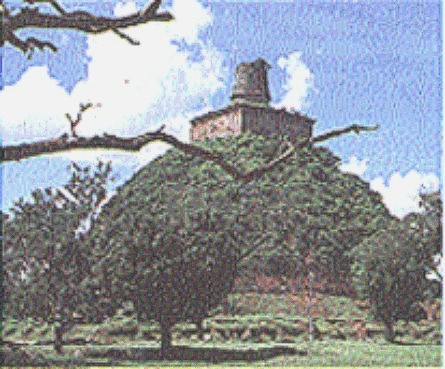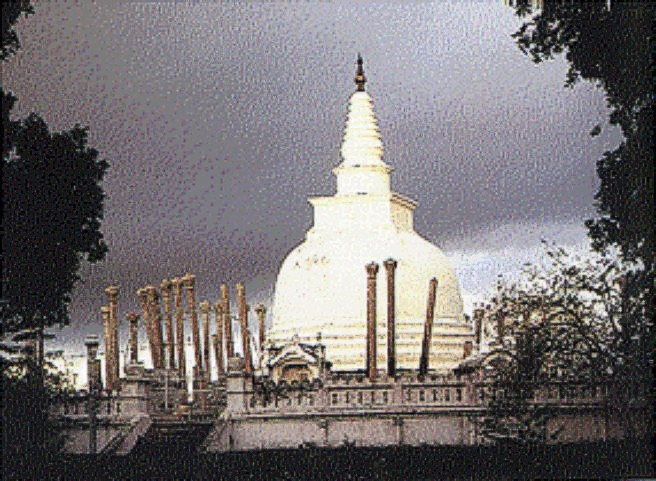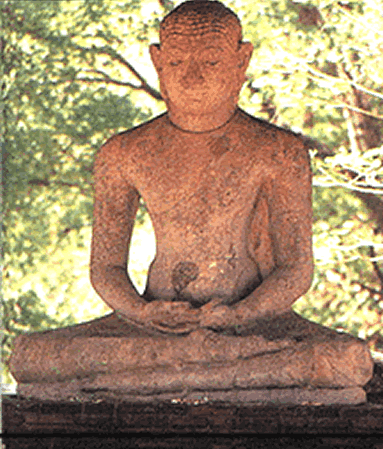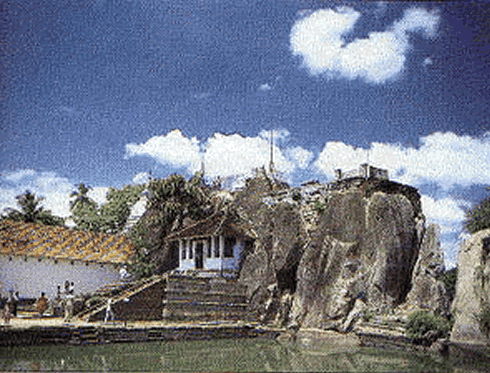Anuradhapura
Its origin, fall and revival
Recorded history of Sri Lanka beginning from the third century B.C. to eighteenth century A.D. is one of the best documented. The island has a collection of historical chronicles and religious writings which have no parallel in South Asia. Pre-eminent is the great chronicle or Mahawansa, composed in the early years of the sixth century A.D.
As legend has it, over 2500 years ago in 500 B.C., Sakya, brother of Princes Badda Kanchana laid the foundation for the city of Anuradhapura under the Asterim Anuradha, auspiciously aspected by the planets. But according to Mahawansa, the city was named after a Minister called Anuradha, a kinsman of Vijaya who landed in Lanka in 543 B.C. and founded the Sinhalese race.
Anuradha founded a village settlement by the Malwatu Oya, where water was readily available. It was in the 5th century B.C. that Pandukabaya (437 B.C. - 367 B.C.) who succeeded Vijaya did honour to this hamlet by making it his capital. He being a great town planner, divided the town into four zones. Little did Anuradha dream that the remote village named after him was so destined. At that time the town depended on rain and natural springs for their domestic needs and ablutions. One of King Pandukabaya's first acts was to remedy this deficiency in order to protect the health of the citizens. He constructed Abaya Wewa for drinking water and Jaya Wewa, a marsh with a great body of water for washing clothes and bathing. The water from Abaya Wewa was supplied through a network of channels.
In A.D. 66, the entire city was served by subterranean channels connected with reservoirs. To see to the sanitation of the town, he had appointed "Nagara Guttikas" or sanitary assistants. There were 500 Chandala scavengers on duty by day and 200 by night, helped by the town guards and sentries. The removal of corpses was entrusted to 150 Chandala Undertakers, who removed the corps to the four cemeteries in the suburbs. The outer city was in charge of Yakka chiefs Kalawela and Chitta. Anuradhapura comes into full light of recorded history with the "events" of the 3rd century B.C. From that time onwards Anuradhapura became the metropolis capital of the entire country and within two or three centuries it became one of the great international centres of Buddhism, the state religion. It was adorned with palaces, temples, monasteries, lakes, gardens, hospitals, cemeteries and working class suburbs. It was a hub of activity where life ran smooth. Pliny said in A.D. 52 that it had a population of two hundred thousand and an area of 256 square miles. Turner believed that it must have been about 300 square miles. Major Skinner after a survey he carried out in 1833 A.D. agreed with him. The magnitude of the city was established by H.C.P. Bell, when he unearthed a street of 9 miles long having on each side, continued mounds of decayed bricks, the relics of the principal streets of Anuradhapura. Two broad roads were constructed to facilitate the movement of peraharas and processions. They were Rajaweediya running from East to West and Mahakalaweediya from North to South. In 204 B.C. there was big market place near the southern gate, where Romans and Phoenicians purchased atomic drugs and departed by the northern gate. King Elara in 205 B.C. constructed a road from Anuradhapura to Mihintale and permitted Brahamin traders to furnish shops with merchandise brought by foreigners.
Fa-Shien, the itinerant Chinese monk who visited Lanka in 412 A.D. says, "In Anuradhapura are many Buddhist laymen, elders and merchants of all trades, whose houses are stately and beautiful. The roads and byways are kept clean and in order. At the four principal streets they have built preaching halls, where on certain days they spread carpets and set forth high seats for the monks who preached "Bana" to the community who come from all quarters to listen to the preaching. He describes accurately the climate, uniform temperatures of the atmosphere with no change during the seasons and the grand constructions which gave the city lasting renown, especially the Brazen Palace with 1000 chambers with richly embellished halls. There were more than 50 to 60 thousand monks of whom 5,000 to 6,000 were fed by the bounty of the King.
After the demise of Vijaya in 505 B.C. the kingdom devolved on his kinsman Pandukabaya in 437 B.C. followed by Muta Siva in 367 B.C. He established parks, playing fields and pleasure gardens one of which was named Maha Megha, a beautiful royal garden planted with fruit and flower bearing plants. There were orchards of jambu, mango and other trees of luscious fruits. To the North of it was Nandana Uyana provided by Devanampiyatissa. At the death of every king there was competition among the royal descendants to ascend the throne. From early times, it was the practice to retain mercenaries from India and other neighbouring countries to protect the reigning monarch and his kingdom. The first to be employed were the Malabars and Cholians, which created animosity and bloodshed. Both the naval and military commands were held by two Malabars, Sena, and Guttika. They took advantage of their position and seized the throne in 237 B.C. and ruled the country for 22 years thus overthrowing the Vijaya dynasty. This easy success encouraged Elara, a descendant of the Malabar tribe in 205 B.C. who invaded the island from the Chola country killing the reigning king Asela and ruling Anuradhapura for 40 years. He eschewed impiety and injustice. Cholian invasions destroyed some of the most beautiful parts of Anuradhapura. However it is said that he administered justice impartially to friend and foe.
Dutugemunu in 140 B.C. re-captured the city of Anuradhapura and rebuilt the demolished structures. The most remarkable of the edifices which he created was the Lova Maha Seya, the Brazen Palace, a monastery which was roofed with plate of copper. It was 100 cubits long on each of its sides and the same height. There were 9 storeys in the supreme palace with 100 apartments in each storey. It was protected by lightening conductors "Chumbakam" made of Amber and Tourmaline. Dutugemunu, second only to King Devanampiyatissa as the champion of the faith, built the great stupa, Ruwanweliseya, which was unique in architecture in the East. King Valagamabahu (B.C. 19) added more Dagabas and Pirivenas. Bhatika Abaya (B.C. 19 A.D.) planted Jasmin creepers on the sides of the broad streets to enhance the beauty of the city and provide flowers for those who worshipped at the viharas. Separate quarters were assigned in the city on both sides of the streets and a special quarter was apportioned for Iran and Arabic countries, the Yonas. Lanka suffered waves of invasions from the mainland India. These brought about the decline of the internal situation in the island. In 933 A.D. a Chola Emperor landed in the North and looted and burnt Anuradhapura. Later he proceeded to Polonnaruwa, which became the centre of Chola administration for 40 years. The Cholas encouraged the worship of the Hindu god Siva at the expense of Buddhism. The sacred city of Anuradhapura, which was the centre of Buddhist worship fell into decline, unable to support the large number of monks. The Ruwanweli Dagaba was destroyed by them. Although the original outline was missing it was still was a mountain of masonry almost 150 feet high. Trees and jungles soon grew upon it but the terrace was comparatively saved.
The Cholians frequently despatched military expeditions to Lanka and the worst of the barbarians was the leader Magha, who in 1214 A.D. landed with an army of 24,000 savage soldiers and the island fell into his power as the country was defenceless, exhausted and impoverished by constant civil war. He ruled Polonnaruwa adopting an intolerant and hostile attitude towards Buddhism. Anuradhapura was abandoned. As a result of the many invasions and the subsequent devastation of the country, pillaging the places of worship, monasteries and other, the population dwindled. The vast population either died in war or due to the starvation or fled to the coastal areas. Ravages of Malaria was one other reason for the de-population of the regime. Finally the jungle tide swallowed up the "Ghost City" within a short time, rendering the once great kingdom, an abode for wild animals such as the elephant, bear and leopard.
When Lanka fell into the hands of the Western conquerors, the Portuguese and the Dutch beginning 1505 A.D. they did not pay any attention to the buried cities, the ruins were unknown to them. Their sole interest was enjoying the profits of the produce of the country such as cinnamon, areconuts and spices. They directed their interest towards pearl fisheries and the mining of gems. They established their power in the coastal regions. The third Western power, the British, enjoyed full sway over the whole island when they captured the Kandyan Kingdom in 1815 A.D. Soon after, they began to explore the remains of the buried cities of Anuradhapura and Polonnaruwa. Fifty years after the rediscovery of Anuradhapura in 1823 A.D. by Backhouse, (C.C.S.), he entered into a close friendship with the monk Naranwita, who had not deserted the remains of the Great Stupa, Ruwanweli but lived within the precincts of the Dagaba paying homage to it. It was the Governor Sir William Henry Gregory in 1878 A.D. who decreed by an edict that Anuradhapura should once again be inhabited and become the capital of at least a province which he carved out as the North Central Province, rescuing the eternal city from pestilence and jungle.
Thereafter, an accurate survey of Anuradhapura was completed and a lithic record of the remains of the Great Stupa was done by Dr. Goldachaidst; but he became a victim of malaria and died a short while after. At the same time Governor Gregory retired from the Government of Ceylon due to severe illness and returned to his home in Ireland. This delayed official patronage for the work undertaken according to the fiat of 1878 by another one year. The benevolent Governor and friend of the poor did not give up his interest and love in the restoration of the sacred city, that from his home in Ireland he advised what should be done by submitting an exhaustive report to the Secretary of State for the Colonies, Lord Carnaarvon. In it he referred to the jungle clearing, exposition of ruins and the rendering of Anuradhapura healthy, by the Government. In this report the following tribute was paid to monk Naranwita's pioneer work. "By far the most important architectural discoveries have been made by a young Buddhist priest, who with the view of "gaining merit" has devoted himself to the clearing and restoration of the Ruwanweli, which before 1873 was a huge shapeless mass of bricks. The priest whom I have referred to, undertook the apparently hopeless task of cleaning and restoring the great structure. He began without any funds. He was not even a native of Anuradhapura, but such was his energy and confidence of success, that his countrymen by degrees began to contribute, and I too was able to strengthen his position by a small contribution during each of my visits, along with a testimonial in the favour of his praiseworthy efforts. It is incredible as to what he had been able to do in so short a time and with such slender means.
As the years rolled by, more and more important landmarks of the ancient city were discovered and restored. Among them were the Sacred Bo Tree, Thuparamaya, Isurumuniya, Jeta Vana Ramaya, Abayagiriya, Mirisewetiye, and Vessagiri. Ruwanweli was the greatest of the shrines built by Dutugemunu, although he did not live to see it completed. Revered through centuries as the first and greatest capital of Lanka, Anuradhapura has survived strange vicissitudes. After Ceylon obtained Independence in the year 1948, D. S. Senanayake, the first Prime Minister of Ceylon, called the "Father of the Nation", established a New Town in Anuradhapura by unveiling a "Lion Pillar" at the entrance to the New Anuradhapura. When the late Rev. Senior of Trinity College, Kandy at the beginning of this century recited the following prophetic lines, neither he nor anyone dreamed that Ceylon would be free and a New Anuradhapura would arise on the outskirts of the Sacred City.
"But most shall he sing of Lanka In the brave new days that come When the races all have blended And the voice of strife is dumb When we leap to a single bugle March to a single drum When the ruined city rises And the palace gleams once more."

Ruwanweli seya

Jetavana

Tuparamaya

Samadhi Pilima

Isurumuniya